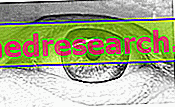Generality
Glaucoma is a subtle disease that affects the eye, slowly destroying the sight. About two million people suffer in Italy, most of whom ignore being affected. Very often, in fact, glaucoma does not cause any symptoms and one notices its presence only when the sight is now compromised. Fortunately, an early diagnosis, associated with the right therapies, is able to block the evolution by minimizing damage to eyesight.
Causes
The silent thief of sight
The term glaucoma identifies a heterogeneous group of diseases characterized by an increase in endocular pressure.

When these natural ways become obstructed and the ratio between the produced aqueous humor and the one eliminated increases, the pressure inside the bulb increases exceeding the normal 14-16 mmHg. If this pressure increase is important or lasts a long time it can damage the optic nerve, a sort of electrical connection that transmits visual information directly to the brain.
Epidemiology
Glaucoma mainly affects the over 40s and its incidence, higher than the north, increases with increasing age (over 60 years the risk of glaucoma is double, over 70 years it increases up to five times).
Risk factors
The chances of developing glaucoma increase in the presence of certain diseases (ocular hypertension, myopia and diabetes), migraine headaches, previous ocular trauma, prolonged use of some drugs (such as cortisone drugs) and in the case of familiarity with the disease.
Symptoms and Complications
The lesion of nerve fibers leads to a progressive narrowing of the visual field, typical of advanced glaucoma. The damage to eyesight is in fact progressive and, since it initially affects only the lateral vision, it goes unnoticed until you reach the loss of much of the vision.
Types of Glaucoma
Doctors make a first important distinction between the various forms of glaucoma by separating those at an open angle from those at a narrow angle .
- In the first case the onset of the disease is slow and progressive due to an alteration of the aqueous humor outflow systems that progresses slowly.
- Due to narrow angle glaucoma, a less common form of the previous one, the disease suddenly appears. Outflow obstruction is more abrupt and severe, causing symptoms such as eye pain, nausea, vomiting, blurred vision and halos around the lights.
There are also other minor forms, with different characteristics and therapeutic options (congenital glaucoma and pigmentary glaucoma).
Prevention
ALL SHAPES (with the exception of congenital glaucoma) ARE PREVENTABLE
When we talk about glaucoma we cannot avoid talking about early prevention. A simple eye examination can in fact block or limit the progression of the disease before major damage occurs.
For this reason, after the age of forty (35 for people at risk), it is advisable to undergo at least one medical examination of the eyes every two years
Care and treatment
If glaucoma is recognized and treated in time, the person can keep their sight for the rest of their life. The current therapeutic options make it possible to control the disease by avoiding the worsening of glaucoma. Unfortunately, all these "cures" are not effective enough to restore lost vision.
Keeping therapy and controls constant over time, it is still possible to establish a long and painless cohabitation with the disease.
drugs
See also: Glaucoma - Drugs for the treatment of Glaucoma
The first approach is pharmacological, generally based on the use of eye drops (blocked beta and prostaglandins). The former are very efficient because they lower the eye pressure by 20-25%; however, they are contraindicated in case of asthma and heart disease, including arrhythmias and atrioventricular blockages.
Prostaglandins are perhaps the most potent drug for lowering eye pressure without incurring the side effects of pilocarpine, a medicine that is still very valid but which, by tightening the pupil a lot, tends to further reduce the visual field.
Surgery
When the pharmacological treatment fails to adequately reduce the intraocular pressure it is possible to resort to surgery. Also in this case there are different techniques based on the type of glaucoma and the characteristics of the patient.
The intervention can use modern lasers that can correct the problem in an outpatient setting. When their use is contraindicated or inadequate to the type and stage of glaucoma, the traditional surgical technique is used. The intervention in most cases allows to significantly reduce the pressure inside the eye. In this way the drop in blood pressure allows the temporary abandonment or at least the reduction of drug therapy.
However, like all surgical procedures, this type of operation is not without its rare complications. For this reason, surgery is generally reserved for cases where there are no other alternatives.
| Eye | Myopia | farsightedness | Presbyopia | Astigmatism | Glaucoma |



